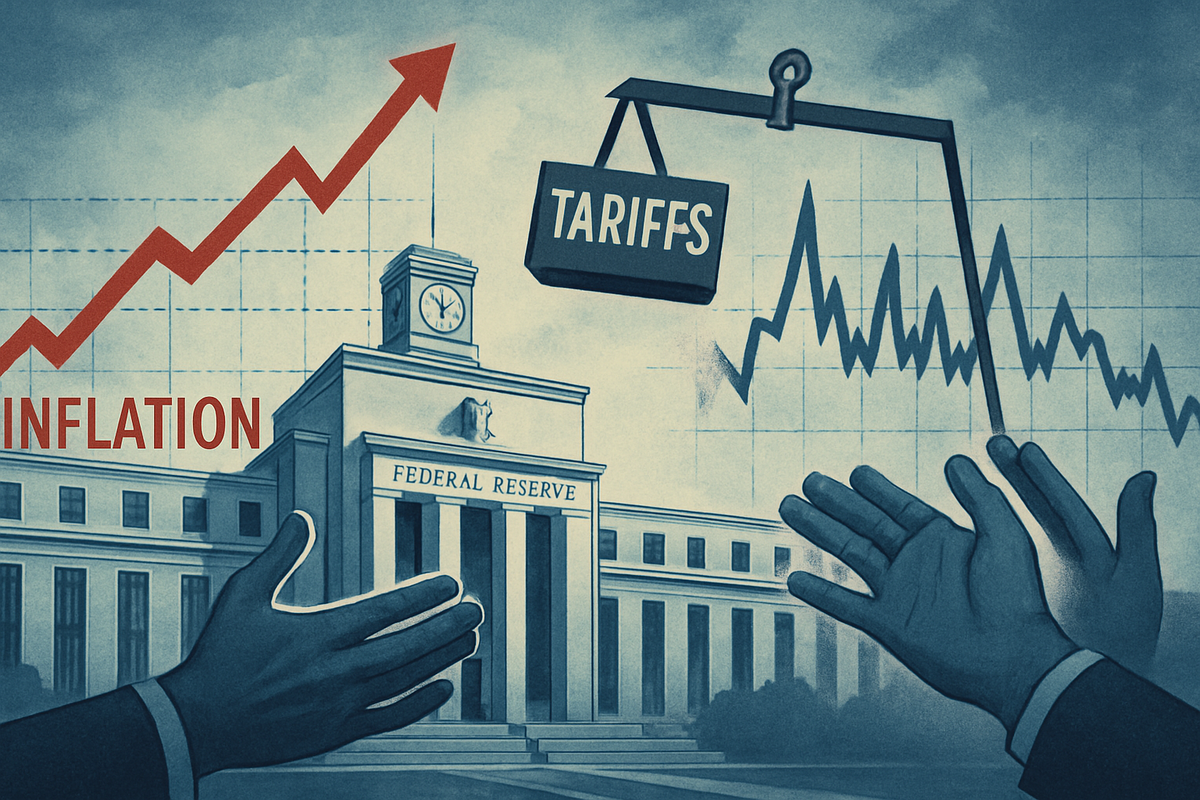
Washington D.C. – The Federal Reserve's arduous battle against inflation is facing an unexpected and persistent challenger: tariffs. Recent comments from a chorus of Fed officials, including Chair Jerome Powell, reveal growing concern that the gradual, yet undeniable, pass-through of tariff costs into consumer prices is significantly complicating monetary policy, casting a long shadow over the future trajectory of interest rates. This "slow-motion transmission" of tariff-induced inflation presents a unique dilemma for policymakers, who are grappling with how to differentiate between temporary price shocks and more enduring inflationary pressures. The uncertainty this creates is reverberating through financial markets, prompting investors to reassess the path forward for the U.S. economy.
The central bank finds itself in a precarious position. While some underlying inflationary pressures appear to be moderating, the persistent upward pull from tariffs threatens to keep headline inflation above the Fed's 2% target for longer than anticipated. This situation has immediate and profound implications, potentially forcing the Fed to maintain a tighter monetary stance than it otherwise would, even as some officials express concern about a softening labor market. The delicate balancing act between controlling inflation and supporting economic growth is becoming increasingly complex, with tariffs adding a layer of unpredictability that could lead to heightened market volatility and a re-evaluation of investment strategies.
Fed Officials Grapple with Persistent Tariff-Driven Inflation
The complexities tariffs introduce to the Federal Reserve's inflation fight have been a dominant theme in recent communications from its top officials. Federal Reserve Chair Jerome Powell, in remarks on October 14, 2025, underscored the challenge posed by the slow integration of tariffs into consumer prices, warning that this could lead to more persistent inflationary pressures down the line. He highlighted that the Fed's preferred measure of inflation has been pushed to 2.9%, with tariffs playing a significant role, even as broader inflationary pressures remain subdued when excluding these duties. Powell's comments suggest a careful monitoring approach, as the Fed seeks to understand if the slow pass-through might accelerate or contribute to sustained inflation.
Adding to the chorus, Minneapolis Fed President Neel Kashkari stated on October 17, 2025, that tariffs "threw a curveball" at the Fed's progress. He noted that the full economic impact of these tariffs is taking longer to materialize than initially expected, with businesses signaling that more significant price increases could emerge early next year as existing inventories are depleted. Federal Reserve Governor Christopher J. Waller, on October 16, 2025, further elaborated, attributing most of the rise in core goods inflation to tariffs based on internal research. He emphasized the distinction between a permanent increase in the price level due to tariffs and their temporary effect on the rate of inflation, suggesting that underlying inflation, excluding tariffs, might be closer to the Fed's target.
Further complicating the outlook, Federal Reserve official Musalem observed on October 17, 2025, that tariff effects are expected to persist until mid-2026, with retailers facing increasing pressure to pass on these elevated costs. Boston Fed President Susan M. Collins (September 30, 2025) acknowledged the added complexity but anticipated a somewhat smaller overall impact. However, Federal Reserve Governor Michael Barr (October 10, 2025) warned that a "sharp increase" in tariffs has exacerbated inflation, potentially leading to a longer-term upward trend as companies eventually pass on higher costs. An analysis by the Federal Reserve Bank of St. Louis (October 16, 2025) concluded that tariffs are already measurably increasing consumer prices, accounting for approximately 0.5 percentage points of headline Personal Consumption Expenditures (PCE) annualized inflation and around 0.4 percentage points of core PCE annualized inflation between June and August 2025, with the full pass-through still ongoing.
Initial market reactions to these disclosures have been somewhat muted but underscore underlying volatility. Following Powell's October 14 remarks, Treasury yields and major stock indices showed little immediate movement, though analysts noted increased volatility in rate-sensitive sectors. Powell's cautious tone was generally interpreted as dovish, contributing to a rise in equities, a dip in Treasury yields, and an increase in gold prices (NYSE: GLD) as an inflation hedge. However, the prevailing sentiment among Fed officials points to heightened economic uncertainty, exacerbated by a recent government shutdown that delayed the release of crucial economic data, further clouding the Fed's visibility on both inflation and labor market conditions. The trade policy uncertainty index, while down from its April peak, remains elevated, posing a potential negative demand shock to the economy.
Corporate Fortunes Diverge Amidst Tariff Headwinds and Fed Adjustments
The dual forces of escalating tariffs and the Federal Reserve's reactive monetary policy are creating a highly bifurcated landscape for public companies, with clear winners and losers emerging across the U.S. economy. Tariffs, essentially taxes on imported goods, directly elevate the cost of doing business for many, leading to either squeezed profit margins or higher consumer prices. This cost pass-through is particularly evident in durable goods sectors like vehicles, electronics, and furniture, where price increases have been notable since early 2025. The Fed's subsequent interest rate cuts, while aimed at stimulating economic activity and softening the blow of tariffs, introduce another layer of complexity, influencing borrowing costs and investment decisions.
Among the clearest beneficiaries are domestic producers of tariffed goods. Industries such as steel, aluminum, copper, and lumber producers are experiencing a significant competitive advantage as tariffs shield them from cheaper foreign competition. Companies like Nucor (NYSE: NUE), Cleveland-Cliffs (NYSE: CLF), U.S. Steel (NYSE: X), and Freeport-McMoRan (NYSE: FCX) are leveraging this protection to command higher pricing power and meet increased domestic demand. Similarly, automotive manufacturers with substantial U.S. production, such as General Motors (NYSE: GM), Ford (NYSE: F), and Tesla (NASDAQ: TSLA), could see benefits from reduced competition from foreign imports, though they still face challenges from tariffs on imported components. Companies with strong brand loyalty and those able to strategically shift their sourcing to non-tariff countries are also better positioned to absorb or mitigate increased costs.
Conversely, businesses heavily reliant on imports are facing significant headwinds. Import/export businesses and manufacturers dependent on imported components are grappling with higher input costs, which can range up to 15% for items like steel, aluminum, and electronics from Mexico and China. This directly impacts their profitability or forces them to raise prices, potentially dampening consumer demand. Homebuilders like D.R. Horton (NYSE: DHI) are also feeling the pinch from increased material costs, exacerbating housing affordability issues. In the consumer goods sector, retailers of imported apparel and electronics are confronting higher wholesale costs, which ultimately translate to increased prices for consumers and potentially reduced sales volumes, particularly in price-sensitive markets.
The technology sector is also experiencing a mixed bag of fortunes. While domestic semiconductor producers might see some protection, tech companies heavily reliant on imported components and finished goods are particularly vulnerable. Imports constitute nearly 90% of computers and electronics sold in the U.S., meaning tariffs are directly driving up prices for smartphones (potentially 26% higher) and laptops (up to 46% higher), disrupting intricate global supply chains. Giants like Apple (NASDAQ: AAPL), with significant manufacturing operations in China, face increased operational costs and potential market access challenges if tariffs escalate. Even software and service providers, though less directly impacted by goods tariffs, could see indirect effects through higher infrastructure costs for hardware and data centers, eventually impacting their pricing models. The Fed's rate cuts aim to provide some relief by lowering borrowing costs, but the pervasive uncertainty and elevated input prices demand strategic adaptation from all businesses to navigate this complex economic environment.
Broader Economic Currents and Echoes of Protectionist Past
The current entanglement of tariffs and the Federal Reserve's inflation fight extends far beyond immediate market reactions, embedding itself within broader industry trends and carrying significant geopolitical and historical implications. Tariffs, by their very nature, directly inflate the cost of imported goods and components, acting as a measurable upward pressure on consumer prices. Estimates suggest that between June and August 2025, tariffs accounted for roughly 0.5 percentage points of headline Personal Consumption Expenditures (PCE) annualized inflation and about 0.4 percentage points of core PCE annualized inflation. This quantifiable impact directly complicates the Fed's mandate of achieving a 2% inflation target, forcing policymakers to contend with price increases that are external to typical demand-side pressures.
This environment is accelerating a fundamental reshaping of global supply chains. A dominant trend is the push towards regionalization and reshoring, as companies prioritize proximity and stability over purely cost-driven global sourcing. A 2025 Deloitte study predicted that 40% of U.S. companies would relocate at least part of their supply chains to North America by 2026, with major players like Apple (NASDAQ: AAPL) actively shifting production to countries like India and Vietnam to mitigate U.S.-China tariff exposure. This is coupled with aggressive supply chain diversification, as businesses seek to de-risk their operations by reducing reliance on single-country sourcing. The complexity of navigating this new trade landscape is also spurring greater technology adoption, with AI and IoT becoming crucial for enhanced supply chain visibility and real-time tariff impact assessments, while increased compliance budgets reflect the growing regulatory burden.
The ripple effects of these tariffs are extensive, impacting both domestic and international competitors and partners. Increased input costs and reduced profit margins are a common lament for businesses heavily integrated into global networks. This has also led to trade rerouting and diversion, with a noticeable decline in the share of U.S. imports from China, while imports from countries like Mexico (NYSE: EWW), which benefit from tariff exemptions under USMCA, have surged. Crucially, U.S. tariffs have often provoked retaliatory tariffs from trading partners, escalating trade wars and further disrupting global commerce. For instance, China's additional tariffs on U.S.-origin goods reached 125% by April 2025. This tit-for-tat dynamic weakens the competitiveness of trading partners and contributes to a broader global economic slowdown, with institutions like J.P. Morgan Global Research and the IMF revising down GDP growth estimates for major economies due to heightened trade policy uncertainty.
From a regulatory and policy standpoint, the current tariff landscape reflects a strategic and assertive shift in U.S. trade policy, often characterized by a renewed "America First" agenda. There's an increasing reliance on executive authority to impose tariffs, frequently under national security justifications (e.g., Section 232 tariffs on steel and aluminum), leading to an unpredictable regulatory environment. New U.S. tariff structures include a 10% baseline tariff on most imported goods, reciprocal tariffs targeting trade-deficit countries, and the elimination of the "de minimis" exemption for low-value shipments from China and Hong Kong. Tariffs are unequivocally being used as a geopolitical tool to manage competition and protect critical industries, raising concerns about the "weaponization" of trade policy and potential legal challenges to the scope of executive trade authority. Historically, these events draw stark comparisons to the infamous Smoot-Hawley Tariff of 1930, a protectionist measure widely blamed for exacerbating the Great Depression through widespread retaliation. The current era, with its emphasis on protecting domestic industries through high duties, echoes the U.S. "restriction period" of tariffs (1861–1933), representing a notable departure from the post-World War II era of promoting free trade and highlighting the recurring debate over the true costs and benefits of protectionism.
Navigating the Uncharted Waters: What Comes Next for Policy and Markets
Looking ahead, the interplay of tariffs and the Federal Reserve's monetary policy is setting the stage for a period of sustained economic and market uncertainty. In the short term (late 2025 to 2026), the Fed is likely to continue with a strategy of cautious easing, implementing gradual interest rate cuts (with another 25 basis points potentially by the end of October 2025 and more into 2026-2027), contingent on a softening labor market and signs of subsiding inflation. However, the persistent inflationary pressure from tariffs introduces significant stagflationary concerns. Should tariffs continue to fuel inflation while economic growth slows and unemployment rises, the Fed could face a profound policy dilemma: combat inflation with higher rates (risking recession) or support growth (risking further inflation). There's also a palpable risk of policy error, where the Fed might ease too quickly, underestimating the stickiness of tariff-driven inflation, potentially leading to an acceleration of prices through 2026 and necessitating corrective rate hikes later.
In the long term (2027 and beyond), the economic landscape could see normalization amidst persistent price pressures. Even with anticipated rate cuts, inflation is expected to remain somewhat elevated, potentially reaching the Fed's 2% target later than initially projected. A prolonged period of tariff-induced inflation could lead to a shift in inflation expectations, potentially unanchoring them and requiring a more aggressive future monetary policy response. This environment also suggests a greater emphasis on supply-side factors in the Fed's policy framework, moving beyond a sole focus on demand-side management. For businesses, strategic pivots are not optional. Further supply chain diversification and reshoring will be critical, as will continued cost pass-through and adaptive pricing strategies. Increased investment in automation and efficiency (including AI) will be vital to offset rising costs and uncertainties, alongside product and market adaptation to navigate the unpredictable regulatory and trade landscape.
The market opportunities and challenges emerging from this environment are multifaceted. Challenges include the specter of higher inflation and interest rates negatively impacting rate-sensitive sectors, reduced consumer purchasing power, and slower global growth. Opportunities, however, exist for domestic industries with strong production capabilities, sectors benefiting from robust AI-related investment, and the financial sector which could see higher interest margins if rates remain elevated. Investors are increasingly advised to increase diversification and closely monitor sector-specific performance, recognizing that the era of seamless global supply chains is receding. Potential scenarios range from a "soft landing" with prolonged inflation, where the Fed successfully cushions the economy but inflation remains stubbornly above target, to a "hard landing" or recession, driven by escalating trade wars or policy missteps. A "stagflationary trap" remains a concern, while an unlikely de-escalation of trade tensions or significant AI-driven resilience could offer more favorable outcomes. The path forward remains highly contingent on the evolving interplay of trade policy, central bank actions, and global economic dynamics.
A Complex Confluence: Summarizing the Tariff-Inflation Conundrum
The ongoing narrative around tariffs and their entanglement with the Federal Reserve's anti-inflation mandate presents a multifaceted challenge to the U.S. and global economies. The key takeaway is clear: tariffs are not merely a trade issue but a significant inflationary force, directly contributing to elevated consumer prices. Federal Reserve analyses indicate that tariffs explain approximately 0.5 percentage points of headline Personal Consumption Expenditures (PCE) annual inflation and 0.4 percentage points of core PCE annual inflation as of August 2025, with global tariff costs estimated to reach $1.2 trillion in 2025, largely borne by consumers. This creates an unenviable dilemma for the Fed, which is simultaneously grappling with a softening labor market and the need to maintain price stability. While some officials advocate for "looking through" these price level increases if inflation expectations remain anchored, the majority acknowledge the substantial upside risks tariffs pose to inflation, complicating the path for future interest rate policy.
Moving forward, the market can expect continued caution and volatility. Economic growth forecasts remain restrained, with the International Monetary Fund (IMF) projecting U.S. GDP growth at 2% for 2025, and J.P. Morgan Global Research lowering its estimate to 1.6% due to trade policy uncertainty. Consumer spending, while currently healthy, is anticipated to slow if tariffs persist and erode purchasing power, while corporate profit margins are expected to contract further. The lasting impact of this period will likely include a more fragmented global economy, accelerating the reconfiguration of supply chains towards regionalization and diversification. This shift, coupled with the erosion of consumer purchasing power and persistent challenges to traditional monetary policy frameworks, signifies a fundamental and potentially enduring change in how global commerce and central bank policies interact.
For investors, vigilance is paramount in the coming months. Closely monitor Federal Reserve communication, particularly FOMC statements and speeches, for insights into the pace and timing of future interest rate cuts and the Fed's evolving assessment of tariff impacts. Inflation data, especially core CPI and PCE, will be critical to determine if tariff-driven goods inflation spills over into services. Labor market data (unemployment, job creation, wage growth) will heavily influence the Fed's dovish inclinations. Furthermore, trade policy developments, including new tariff announcements, retaliatory measures, and legal challenges to existing duties, could significantly alter market sentiment. Pay close attention to corporate earnings and guidance, focusing on companies with international supply chains and their strategies for adaptation. Finally, keep an eye on global economic health and currency fluctuations, as these broader dynamics will continue to shape the investment landscape in this era of persistent tariff-induced uncertainty.
This content is intended for informational purposes only and is not financial advice







